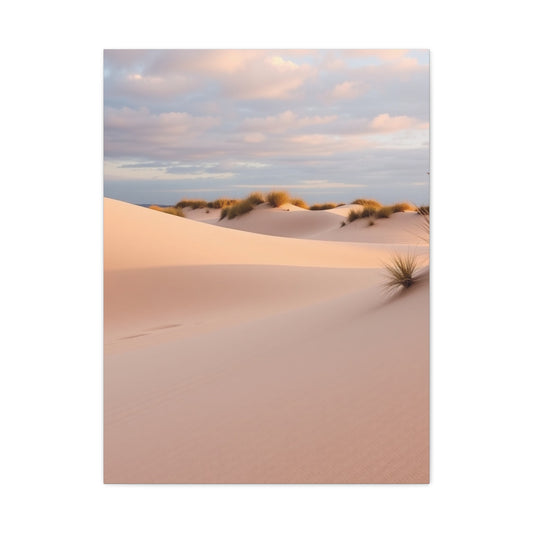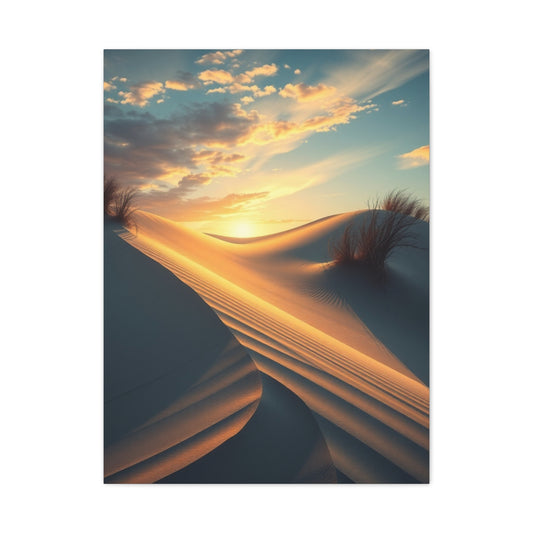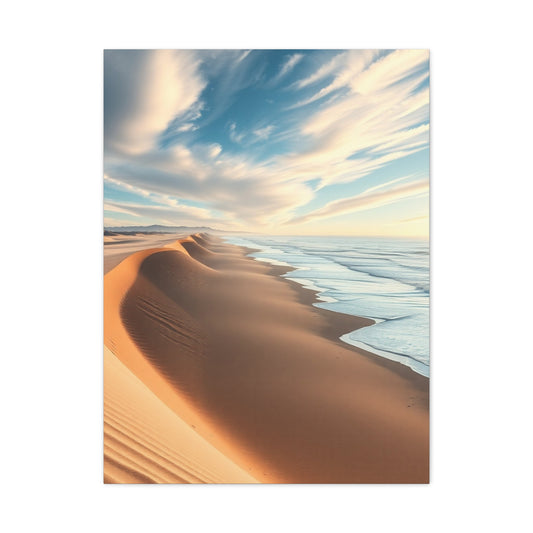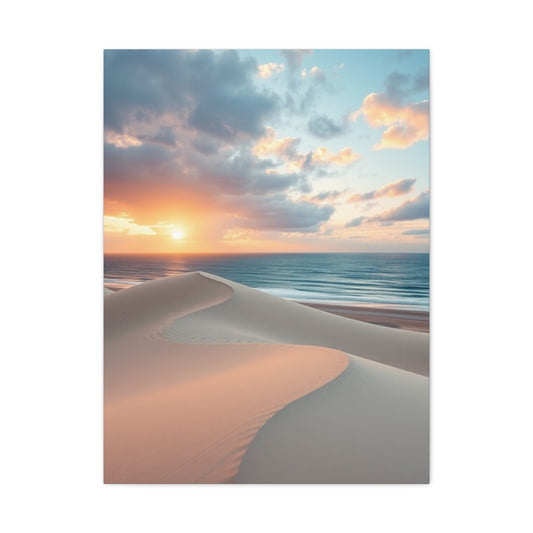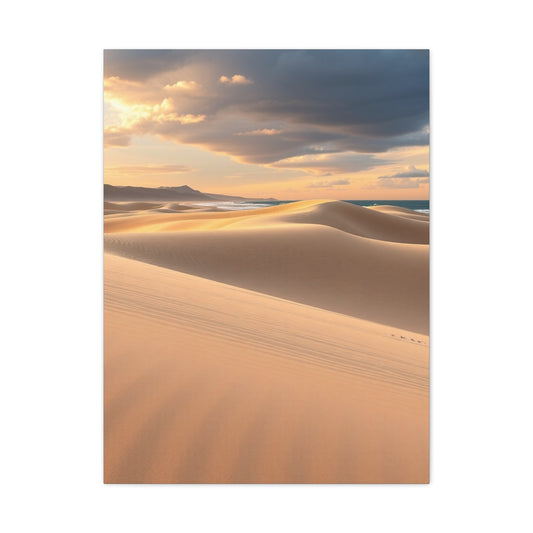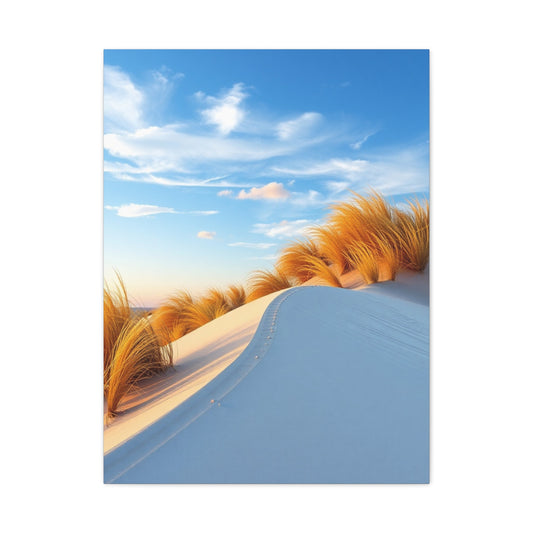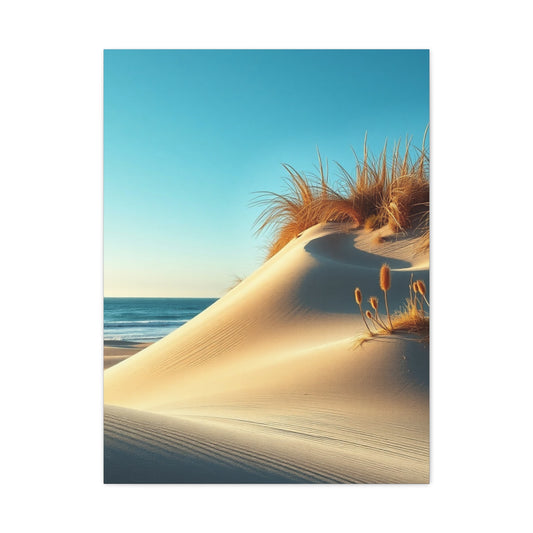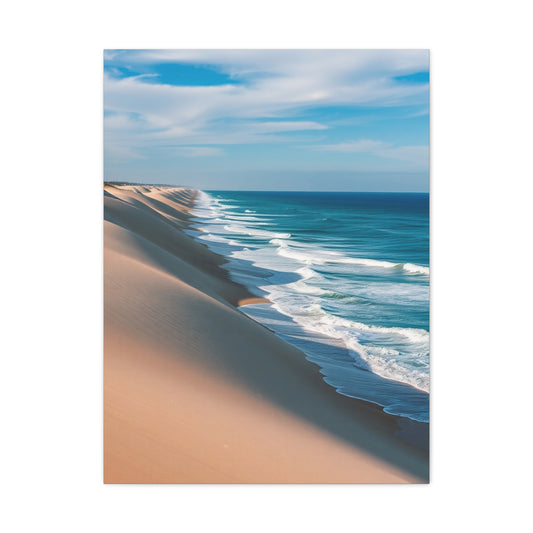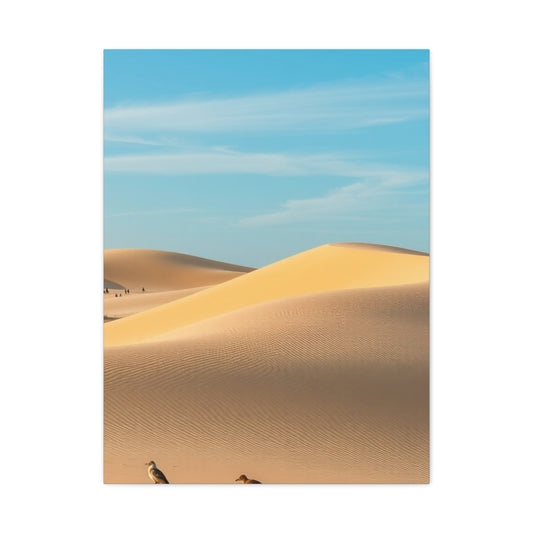Coastal Watercolor Wall Art: Sand Dunes as the Ultimate Artistic Escape
The realm of maritime-themed watercolor painting represents one of the most captivating and emotionally resonant forms of artistic expression available to contemporary creators. When artists embark upon the journey of capturing coastal landscapes through the medium of watercolor, they enter into a dialogue with nature's most dynamic and ever-changing environments. The interplay between land and sea, the subtle gradations of color found in sandy terrain, and the atmospheric conditions that define seaside locations create an inexhaustible source of inspiration for those who seek to translate the beauty of coastal regions onto paper.
Watercolor painting, with its inherent fluidity and transparency, serves as the perfect medium for capturing the ephemeral qualities that define coastal environments. The way pigments blend and flow across wet paper mirrors the natural movement of tides, the shifting of sand particles in the wind, and the gentle transitions between sky and water that characterize maritime landscapes. Artists who specialize in coastal watercolor work often find themselves drawn to the challenge of representing these transient moments, where light, atmosphere, and natural elements converge to create scenes of extraordinary beauty.
The process of creating sand dunes watercolor coastal wall art requires not only technical proficiency but also a deep understanding of the natural phenomena that shape these environments. Sand dunes, in particular, present unique challenges and opportunities for watercolor artists. Their organic forms, created through the continuous action of wind and weather, offer endless variations in shape, texture, and color. The subtle interplay of light and shadow across dune surfaces creates complex patterns that shift throughout the day, providing artists with a rich vocabulary of visual elements to explore and interpret.
Understanding the Natural Beauty of Sand Dune Formations
Sand dunes represent some of nature's most sculptural creations, formed through the patient accumulation and redistribution of sand particles over extended periods. These geological formations serve as transitional zones between terrestrial and marine environments, creating unique ecosystems that support specialized plant and animal communities. For watercolor artists, sand dunes offer an exceptional opportunity to explore the relationship between form and color, as these structures exhibit a remarkable range of tonal variations throughout different times of day and seasonal cycles.
The formation process of sand dunes involves complex interactions between wind patterns, sand particle size, and vegetation coverage. As wind carries sand particles inland from beaches, these materials accumulate around natural obstacles such as rocks, driftwood, or pioneer plant species. Over time, these small accumulations grow into larger formations, developing the characteristic undulating profiles that make sand dunes such compelling subjects for artistic interpretation.
The color palette found in sand dune environments extends far beyond the simple beiges and browns that might initially come to mind. Depending on the mineral composition of the sand, geographic location, and lighting conditions, sand dunes can exhibit an extraordinary range of colors, from warm golden tones to cool purplish-grays, from vibrant oranges and reds to subtle lavenders and blues. This diversity of color provides watercolor artists with rich opportunities for experimentation and expression.
The texture of sand dunes presents another layer of visual complexity that watercolor artists must learn to interpret and represent. The surface of a sand dune is rarely uniform, displaying patterns created by wind action, including ripple marks, crescentic forms, and areas of smooth, consolidated sand contrasted with regions of loose, shifting material. These textural variations create opportunities for artists to employ different watercolor applications, from smooth washes to more complex dry brush work and granulation effects.
The Significance of Potter's Pink in Coastal Watercolor Work
Potter's Pink, a unique and versatile pigment, has become an indispensable component in the palette of many coastal watercolor artists. This particular color, with its subtle warmth and gentle saturation, possesses qualities that make it exceptionally well-suited for capturing the nuanced color relationships found in seaside environments. The pigment's ability to harmonize with both warm and cool colors makes it an ideal mixing partner for creating the complex color relationships that characterize coastal landscapes.
The origins of Potter's Pink can be traced back to ceramic and pottery glazes, where this particular hue was prized for its ability to create soft, natural-looking surfaces. When adapted for use in watercolor painting, Potter's Pink retains many of these desirable qualities, offering artists a color that can serve as both a primary component and a subtle modifier in their color mixing strategies. Its gentle opacity allows it to be used in various concentrations, from transparent glazes to more substantial color applications.
In the context of sand dune watercolor painting, Potter's Pink proves particularly valuable for several reasons. First, its warm undertones naturally complement the golden and amber hues commonly found in sandy environments. Second, its subtle saturation prevents it from overwhelming other colors in a composition, making it an excellent choice for creating harmonious color relationships. Third, its mixing properties allow it to serve as a unifying element throughout a painting, helping to create coherent color schemes that reflect the natural unity found in coastal environments.
The versatility of Potter's Pink extends beyond its role in representing sandy surfaces. This pigment can be effectively employed in depicting sky conditions, water reflections, and even vegetation elements found in coastal environments. When mixed with blues, it creates beautiful atmospheric grays perfect for overcast skies or distant water surfaces. Combined with greens, it produces the subtle, sun-bleached tones often observed in coastal vegetation. Mixed with warmer colors like cadmiums or earth tones, it enhances the golden light quality that characterizes many coastal scenes.
Color Theory and Pigment Selection for Maritime Landscapes
The successful creation of coastal watercolor paintings relies heavily on a thorough understanding of color theory and careful pigment selection. Coastal environments present artists with unique color challenges, as these settings often feature subtle color relationships and complex atmospheric effects that require sophisticated color mixing strategies. The interplay between natural elements in coastal settings creates color phenomena that demand both technical skill and artistic sensitivity to represent effectively.
Primary color selection forms the foundation of any successful coastal watercolor palette. While traditional primary triads can serve as starting points, coastal painting often benefits from expanded primary selections that include both warm and cool versions of each primary color. This approach provides artists with greater flexibility in mixing the subtle color variations characteristic of maritime environments. For blues, both ultramarine and cerulean provide different qualities essential for representing various aspects of coastal scenes. Ultramarine, with its deep, warm undertones, excels in depicting deep water and shadow areas, while cerulean's cooler, more neutral character makes it ideal for sky work and atmospheric effects.
Yellow selections in coastal work often include both cadmium yellows and more subtle options like Naples yellow or raw sienna. These warmer, earthier yellows prove particularly valuable in capturing the golden light quality that characterizes many coastal environments. The inclusion of these earth-based yellows also facilitates the mixing of natural-looking sand colors and vegetation tones commonly found in dune environments.
Red selections for coastal work typically emphasize subtle, muted options rather than brilliant, saturated reds. Colors like Potter's Pink, light red, or Venetian red provide the warm undertones necessary for mixing realistic sand colors and atmospheric effects without introducing overly intense color notes that might disrupt the natural harmony of coastal scenes. These subtle reds also prove valuable in creating the warm undertones often observed in late afternoon or early morning coastal light.
Earth colors play crucial roles in coastal watercolor palettes, providing the foundation for realistic representation of sandy surfaces, weathered wood, and natural vegetation. Raw sienna, burnt sienna, and raw umber offer different temperature and intensity options for mixing natural-looking earth tones. Yellow ochre and gold ochre provide additional options for capturing the golden quality of sand and dried vegetation commonly found in coastal environments.
Brushwork Strategies for Capturing Dune Textures
The representation of sand dune textures in watercolor requires a diverse repertoire of brushwork approaches, each suited to capturing different aspects of these complex natural surfaces. The key to successful dune texture representation lies in understanding how different brush applications can mimic the various ways light interacts with sand surfaces, from smooth, consolidated areas to regions of loose, shifting particles.
Flat wash applications serve as the foundation for most sand dune representations, providing the basic color and tonal structure upon which more complex textures can be built. These initial washes should be applied with careful attention to color temperature and value relationships, as they establish the overall lighting conditions and spatial relationships within the composition. The key to effective flat wash application in dune painting lies in maintaining consistent moisture levels and working quickly enough to avoid unwanted hard edges while allowing sufficient time for proper color development.
Wet-in-wet applications prove particularly valuable for creating the soft, atmospheric effects often observed in coastal environments. This approach involves applying pigment to damp paper or into wet pigment areas, allowing colors to blend and flow naturally. In dune painting, wet-in-wet work excels at capturing the hazy, atmospheric conditions that often characterize coastal environments, as well as the soft transitions between light and shadow areas on dune surfaces.
Dry brush work represents another essential component of dune texture representation. This approach involves using brushes with minimal water content to create broken, textural marks that effectively simulate the granular quality of sand surfaces. Different brush sizes and shapes provide varying textural effects, from fine detail work using small rounds to broader textural passages created with larger flat brushes. The key to effective dry brush work lies in controlling moisture levels and maintaining appropriate pressure to achieve the desired degree of coverage and texture.
Stippling and dabbing techniques offer additional options for creating specific textural effects in sand dune paintings. These approaches involve applying pigment through repeated brush contacts with the paper surface, creating irregular patterns that effectively simulate the random distribution of sand particles. Natural sea sponges can also be employed for similar effects, providing organic, irregular textures that complement brush-created passages.
Composition Principles for Coastal Landscape Watercolors
The creation of compelling sand dunes watercolor coastal wall art requires careful attention to compositional principles that enhance the visual impact and emotional resonance of maritime landscapes. Coastal environments offer unique compositional opportunities and challenges, as these settings typically feature strong horizontal elements, expansive spaces, and dynamic interactions between different natural systems that must be organized into coherent, engaging compositions.
The horizon line placement represents one of the most crucial compositional decisions in coastal landscape painting. Traditional compositional guidelines suggest avoiding placement of the horizon at the center of the composition, but coastal subjects often benefit from more nuanced approaches to horizon positioning. High horizon placements emphasize foreground elements such as sand dunes, beach vegetation, and tidal zones, creating intimate, ground-level perspectives that invite viewers to explore textural and color details. Low horizon placements, conversely, emphasize sky conditions and atmospheric effects, creating more expansive, contemplative compositions that capture the grandeur of coastal environments.
Leading lines play particularly important roles in coastal compositions, as these environments naturally provide numerous linear elements that can guide viewer attention through the pictorial space. Sand dune contours create elegant, flowing lines that can lead the eye from foreground to background elements. Beach edges, where sand meets water, provide strong directional elements that can be used to create dynamic compositional movements. Vegetation patterns, from individual plants to larger groupings, offer additional opportunities for creating compositional structure through linear arrangement.
The rule of thirds, while not absolute, provides a useful framework for organizing coastal compositions. Placing key compositional elements such as prominent dune formations, distinctive vegetation groupings, or notable architectural features at thirds intersections often creates more dynamic, visually engaging arrangements than centered placements. However, coastal environments sometimes benefit from more symmetrical approaches, particularly when capturing reflective water surfaces or emphasizing the expansive quality of maritime landscapes.
Foreground, middle ground, and background relationships require careful consideration in coastal watercolor work. Effective spatial organization helps create the sense of depth and atmosphere that characterizes successful landscape paintings. Foreground elements in coastal compositions might include detailed dune textures, beach debris, or prominent vegetation specimens that provide immediate visual interest and establish scale relationships. Middle ground elements typically include major landscape features such as dune ridges, water bodies, or architectural elements that provide compositional anchors and transitional elements between foreground and background areas.
Light and Atmosphere in Maritime Watercolor Painting
The representation of light and atmospheric conditions represents one of the most challenging and rewarding aspects of coastal watercolor painting. Coastal environments are characterized by unique lighting phenomena that result from the interaction between land, water, and atmospheric conditions. Understanding these phenomena and developing technical approaches for representing them effectively is essential for creating convincing and emotionally compelling coastal watercolor works.
Coastal light possesses distinctive qualities that differentiate it from inland lighting conditions. The presence of large water bodies creates reflective surfaces that bounce and scatter light, resulting in more complex and variable lighting conditions. The higher humidity levels commonly found in coastal environments affect light transmission and scattering, often creating softer, more diffused lighting conditions that are particularly conducive to watercolor representation. The constant movement of air masses over water surfaces creates dynamic atmospheric conditions that change rapidly throughout the day, providing artists with constantly shifting lighting scenarios to observe and interpret.
Morning light in coastal environments often exhibits a particular clarity and coolness that results from overnight cooling and stable atmospheric conditions. This light quality is characterized by clean, crisp shadows and subtle color temperatures that emphasize the blue end of the spectrum. Watercolor artists can capture these conditions through careful attention to color temperature relationships and restrained use of warm colors in shadow areas. The transparency of watercolor medium makes it particularly well-suited for representing the clean, luminous quality of morning coastal light.
Midday coastal light presents different challenges and opportunities for watercolor artists. The high sun angle creates strong contrasts between illuminated and shadowed areas, while the intense light levels can wash out subtle color relationships. Successful representation of midday coastal conditions often requires careful value planning and strategic use of color intensity to maintain visual interest without sacrificing the authentic quality of intense coastal illumination. The granulating properties of certain watercolor pigments can be particularly effective in capturing the shimmering, heat-affected atmosphere of midday coastal environments.
Late afternoon and evening light in coastal settings provides some of the most dramatic and colorful conditions for watercolor interpretation. The low sun angle creates long shadows and warm color temperatures that can transform ordinary coastal scenes into extraordinary visual experiences. The interaction between warm sunlight and cool atmospheric conditions creates complex color relationships that challenge artists to employ sophisticated color mixing strategies. Watercolor's natural tendency toward warm-cool color interactions makes it an ideal medium for capturing these dramatic lighting conditions.
Paper Selection and Preparation for Coastal Watercolors
The choice of watercolor paper significantly impacts the success of coastal landscape paintings, as different paper characteristics affect pigment behavior, texture development, and overall visual results. Coastal subjects, with their emphasis on atmospheric effects and natural textures, benefit from careful paper selection that supports the specific technical approaches required for effective maritime landscape representation.
Paper weight represents a fundamental consideration in coastal watercolor work. Heavier papers, typically 300 lb or greater, provide superior dimensional stability and can withstand aggressive wet-in-wet techniques without excessive buckling or cockling. This stability proves particularly valuable in coastal painting, where large wash applications and extended working times are often necessary to achieve desired atmospheric effects. The reduced tendency toward buckling also facilitates more controlled brush work and precise edge management, both crucial for successful coastal landscape execution.
Surface texture, or tooth, affects pigment deposition and texture development in ways that are particularly relevant to coastal subjects. Hot-pressed papers, with their smooth surfaces, excel at detailed work and precise edge control, making them suitable for architectural elements or highly detailed foreground passages in coastal compositions. Cold-pressed papers provide moderate texture that supports both smooth wash applications and textural effects, making them versatile choices for general coastal landscape work. Rough papers offer the most pronounced texture, which can effectively enhance representations of sandy surfaces, weathered materials, and atmospheric effects.
Paper sizing affects pigment absorption and working time, both crucial factors in coastal watercolor execution. Well-sized papers allow for extended working times and facilitate smooth wash applications, while papers with minimal sizing absorb pigment more rapidly, creating different textural effects and shorter working windows. Coastal painting often benefits from papers that provide moderate working times, allowing sufficient control for smooth washes while supporting textural development where desired.
Paper preparation can enhance the effectiveness of coastal watercolor work through strategic preliminary steps. Light pencil sketches help establish compositional structure and guide subsequent paint application. Masking applications can preserve highlight areas and facilitate complex layering strategies. Paper stretching, while not always necessary with heavy papers, can provide additional dimensional stability for extended working sessions.
The color of watercolor paper, while subtle, can affect final color relationships in coastal paintings. Most watercolor papers exhibit slight warm or cool biases that influence overall color harmony. Understanding these subtle color influences allows artists to make informed paper selections that complement their intended color schemes and enhance overall visual coherence.
Layering Strategies for Building Complex Coastal Compositions
The development of sophisticated coastal watercolor paintings often requires strategic layering approaches that build complexity gradually while maintaining the luminous, transparent qualities that define the medium. Coastal subjects, with their complex interrelationships between different natural systems and their subtle color harmonies, particularly benefit from thoughtful layering strategies that allow for controlled development of visual complexity.
Initial wash applications establish the fundamental color and value structure upon which subsequent layers build. These foundational layers should address overall lighting conditions, basic color temperature relationships, and primary compositional elements. In coastal painting, these initial applications might include sky washes that establish atmospheric conditions, basic water color applications, and fundamental sand or vegetation color establishments. The key to successful foundation work lies in maintaining appropriate color intensity and value relationships that support subsequent layer development.
Subsequent layers can address more specific elements such as cloud formations, water surface effects, vegetation details, and textural development. Each layer should contribute to overall compositional coherence while adding specific visual information. The transparency of watercolor allows lower layers to influence upper applications, creating complex color interactions that enhance overall visual richness. This layering process requires careful planning to ensure that successive applications enhance rather than muddy underlying work.
Timing considerations play crucial roles in successful layering strategies. Each layer must be appropriately dry before subsequent applications to prevent unwanted color mixing or edge effects. However, strategic applications into slightly damp lower layers can create controlled blending effects that enhance natural transitions between different elements. Understanding the drying characteristics of different pigments and paper types allows for more sophisticated timing strategies that enhance layering effectiveness.
Selective layering approaches can emphasize specific compositional elements while maintaining overall unity. Foreground areas might receive more extensive layering to enhance detail and visual interest, while background areas remain more simply treated to maintain atmospheric perspective. This selective approach helps guide viewer attention while maintaining overall compositional balance.
Color intensity management throughout the layering process requires careful attention to avoid overly saturated results that compromise the natural quality of coastal subjects. Each layer should contribute to overall color development while maintaining appropriate intensity relationships. This often involves using more subdued color mixtures in upper layers, allowing lower layers to provide color foundation while upper applications contribute detail and refinement.
Capturing Movement and Energy in Coastal Scenes
Coastal environments are characterized by constant movement and dynamic energy that present both challenges and opportunities for watercolor artists. The interaction between wind, water, and sand creates ever-changing patterns and effects that require specific approaches to capture effectively in static watercolor paintings. Understanding these natural phenomena and developing technical strategies for representing them enhances the ability to create coastal watercolors that convey the vital energy of maritime environments.
Wave action represents one of the most dynamic elements in coastal scenes, creating patterns of movement that change constantly as water interacts with shore formations. Effective representation of wave energy requires understanding of wave formation, behavior, and visual characteristics at different scales and conditions. Small wavelets create subtle surface textures that can be suggested through controlled brush work and strategic pigment placement. Larger wave formations require more dramatic value contrasts and careful attention to form and movement patterns.
Wind effects manifest in numerous ways within coastal environments, from the movement of vegetation to the formation of sand patterns to the shaping of cloud formations. Representing wind effects requires careful observation of how different materials respond to air movement and strategic use of watercolor techniques that suggest motion and energy. Vegetation movement can be implied through dynamic brush strokes and strategic edge treatment that suggests flexibility and response to air currents.
Sand movement, while often subtle, creates distinctive patterns and effects that contribute to the overall sense of dynamism in coastal environments. Wind-blown sand creates ripple patterns, particle suspension effects, and gradual landscape modifications that can be incorporated into watercolor representations. These effects require careful observation and selective representation to maintain visual coherence while suggesting the ongoing processes that shape coastal landscapes.
Tidal effects create dramatic changes in coastal environments, revealing and concealing different landscape elements as water levels fluctuate. The representation of tidal effects in watercolor can enhance the sense of temporal dynamism and natural process that characterizes coastal settings. Strategic inclusion of elements such as wet sand areas, tidal pools, and partially submerged formations can suggest the ongoing interaction between land and sea that defines coastal environments.
Light movement, created by passing clouds and changing atmospheric conditions, contributes significantly to the dynamic quality of coastal environments. The representation of changing light conditions requires careful attention to shadow patterns, color temperature variations, and atmospheric effects that suggest temporal progression and natural process.
Advanced Color Mixing for Natural Sand Tones
The creation of convincing sand colors in watercolor painting requires sophisticated color mixing strategies that account for the complex mineral compositions and lighting conditions that influence sand appearance in natural settings. Sand colors extend far beyond simple browns and tans, encompassing a remarkable range of hues that reflect local geology, lighting conditions, and moisture content. Developing expertise in mixing natural sand tones enhances the authenticity and visual appeal of coastal watercolor work.
Understanding sand composition provides the foundation for effective color mixing strategies. Different sand types exhibit distinctive color characteristics based on their mineral content, source materials, and weathering history. Quartz-based sands typically exhibit cooler, more neutral color tendencies, often requiring color mixtures that emphasize gray and blue undertones. Feldspar-rich sands display warmer characteristics with pink and yellow undertones that require different mixing approaches. Shell-fragment sands introduce calcium carbonate components that create distinctive white and cream tones that must be carefully balanced with other color elements.
Lighting conditions dramatically affect sand color appearance, requiring flexible mixing approaches that can accommodate different illumination scenarios. Direct sunlight emphasizes warm color components and increases overall color intensity, requiring mixtures that include adequate warm undertones without becoming overly saturated. Overcast conditions shift color perception toward cooler ranges and reduce overall intensity, necessitating different mixing strategies that emphasize subtle color relationships and muted intensities.
Moisture content significantly influences sand color appearance, creating darker, more saturated tones in wet areas and lighter, more reflective surfaces in dry regions. Representing these moisture-related color variations requires understanding of how water affects pigment behavior and developing mixing strategies that effectively capture the visual differences between wet and dry sand surfaces. Wet sand areas often benefit from slightly darker value mixtures with increased color saturation, while dry sand representation typically employs lighter values with more subtle color relationships.
Potter's Pink serves as an invaluable component in sand color mixing strategies, providing warm undertones that enhance the natural quality of sand representations without introducing excessive color intensity. This pigment's subtle warmth complements the earth tones commonly used in sand color mixtures, creating harmonious relationships that effectively simulate natural sand colors. The mixing flexibility of Potter's Pink allows it to serve various roles in sand color development, from primary mixture components to subtle color modifiers that enhance overall color harmony.
Temperature control in sand color mixing requires careful balancing of warm and cool color components to achieve natural-looking results. Excessive warm color emphasis can result in overly orange or red sand tones that appear artificial, while too much cool color influence can create gray or purple casts that compromise natural appearance. Successful sand color mixing typically involves subtle temperature adjustments that maintain natural color relationships while accommodating specific lighting and compositional requirements.
Inspiration from Master Watercolorists and Contemporary Artists
The tradition of watercolor landscape painting provides rich sources of inspiration and instruction for contemporary artists working in coastal subjects. Historical masters and contemporary practitioners offer diverse approaches, technical innovations, and aesthetic perspectives that can inform and enhance personal artistic development in coastal watercolor work. Understanding these influences while developing individual artistic voices creates opportunities for meaningful contribution to the ongoing evolution of watercolor landscape painting.
J.M.W. Turner's revolutionary approach to watercolor landscape painting established many of the foundations upon which contemporary coastal painting builds. Turner's masterful handling of atmospheric effects, his bold color choices, and his ability to capture the dynamic energy of maritime environments continue to inspire watercolor artists today. His innovative wet-in-wet techniques and his understanding of color relationships in atmospheric conditions provide timeless lessons for coastal watercolor practitioners. Turner's emphasis on emotional response to landscape subjects offers important guidance for contemporary artists seeking to create works that transcend mere visual documentation.
John Singer Sargent's watercolor work, while perhaps more famous for figurative subjects, includes remarkable landscape and coastal pieces that demonstrate sophisticated handling of light, color, and composition. Sargent's confident brushwork and his ability to suggest complex subjects with economical means provide excellent examples for contemporary coastal painters. His understanding of color temperature relationships and his strategic use of paper white for luminous effects offer valuable technical insights for coastal watercolor development.
Contemporary watercolor artists continue to expand the possibilities of the medium through innovative approaches and fresh perspectives on traditional subjects. Artists like Alvaro Castagnet, Joseph Zbukvic, and Herman Pekel have developed distinctive approaches to coastal and maritime subjects that demonstrate the continued vitality and relevance of watercolor landscape painting. Their work showcases contemporary color sensibilities, innovative compositional approaches, and sophisticated technical handling that inspire new directions in coastal watercolor work.
Regional watercolor traditions offer additional sources of inspiration that reflect specific geographic and cultural influences on landscape interpretation. Australian watercolorists have developed distinctive approaches to coastal subjects that reflect the unique characteristics of their maritime environments. British watercolor traditions continue to evolve while maintaining connections to the historical foundations of landscape watercolor painting. American regional approaches reflect the diversity of coastal environments across different geographic areas, from the rocky shores of Maine to the subtropical environments of Florida.
Contemporary plein air movements emphasize direct observation and immediate response to landscape subjects, offering valuable perspectives on authentic representation of coastal environments. These approaches balance traditional watercolor techniques with fresh observational strategies that enhance the immediacy and authenticity of coastal landscape representation. The emphasis on direct experience and rapid execution characteristic of plein air work can inform studio practices and enhance overall artistic development.
Exhibition Preparation and Professional Presentation
The professional presentation of sand dunes watercolor coastal wall art requires careful attention to exhibition standards and presentation methods that enhance visual impact while demonstrating artistic professionalism. Whether preparing works for gallery exhibition, art fair participation, or studio sales, proper presentation significantly influences viewer reception and commercial viability of coastal watercolor works.
Professional photography documentation serves as a crucial foundation for exhibition preparation, providing high-quality images necessary for promotional materials, online presence, and submission requirements. Proper lighting, color accuracy, and compositional presentation in photographic documentation ensure that reproduced images accurately represent original artworks. Professional photography also creates permanent records that support authentication and insurance requirements while facilitating remote viewing and evaluation opportunities.
Artist statements and descriptive materials enhance viewer understanding and appreciation of coastal watercolor works by providing context, inspiration sources, and technical information that enriches the viewing experience. Well-crafted artist statements balance accessibility with substance, offering insights into creative processes, artistic intentions, and personal connections to coastal subjects without overwhelming or limiting viewer interpretation. Technical notes regarding materials and methods can enhance credibility while educating viewers about watercolor processes and challenges.
Pricing strategies for coastal watercolor works require consideration of multiple factors including size, complexity, time investment, materials costs, and market conditions. Professional pricing reflects the value of artistic skill, creative vision, and technical execution while remaining accessible to target audiences. Consistent pricing policies demonstrate professionalism and facilitate clear communication with potential collectors and gallery partners.
Portfolio development and organization enhance professional presentation by providing systematic access to body of work information and supporting materials. Well-organized portfolios facilitate efficient communication with galleries, collectors, and other art professionals while demonstrating serious commitment to artistic practice. Digital portfolios complement physical materials and provide flexible presentation options for various professional contexts.
Marketing and promotion strategies for coastal watercolor artists benefit from understanding target audiences and appropriate communication channels. Social media platforms provide opportunities for regular engagement with interested audiences while building recognition and following. Art fair participation creates direct contact opportunities with collectors and provides market feedback that informs future creative and business decisions. Gallery relationships offer professional validation and expanded market access while providing exhibition opportunities that enhance artistic credibility.
Conclusion:
The journey of creating sand dunes watercolor coastal wall art represents far more than a simple artistic exercise; it embodies a profound engagement with the natural world and a commitment to translating the ephemeral beauty of maritime landscapes into lasting visual expressions. Throughout this comprehensive exploration, we have examined the multifaceted nature of coastal watercolor painting, from the foundational understanding of natural phenomena that shape these environments to the sophisticated methods required for their authentic representation.
The mastery of coastal watercolor painting demands a synthesis of scientific observation, artistic sensitivity, and technical proficiency that few other subjects require in equal measure. The dynamic nature of coastal environments, with their constantly shifting light conditions, atmospheric effects, and natural processes, challenges artists to develop flexible approaches that can capture both the immediate visual impact and the underlying essence of these remarkable landscapes. The integration of pigments like Potter's Pink into sophisticated color mixing strategies exemplifies the kind of thoughtful material selection that distinguishes professional coastal watercolor work from amateur attempts.
The watercolor medium itself serves as the perfect vehicle for coastal landscape expression, its inherent transparency and fluidity naturally echoing the atmospheric qualities and dynamic processes that define maritime environments. The wet-in-wet techniques that create those soft, atmospheric transitions mirror the natural blending of elements in coastal settings, while the controlled unpredictability of watercolor behavior offers opportunities for happy accidents that can enhance the organic quality of coastal representations. This natural affinity between medium and subject matter creates opportunities for artistic expression that would be difficult to achieve through other painting approaches.
The compositional challenges presented by coastal subjects demand sophisticated understanding of spatial relationships, atmospheric perspective, and the visual dynamics created by the interaction between land, sea, and sky. The horizontal emphasis common to coastal landscapes requires careful consideration of vertical elements and spatial division to create engaging, balanced compositions that avoid monotony while maintaining the expansive quality that characterizes these environments. The successful resolution of these compositional challenges creates works that not only document the visual appearance of coastal locations but capture their emotional and spiritual essence.
The preservation and professional presentation of coastal watercolor works represents a crucial final stage that ensures these artistic achievements maintain their impact and value over time. The vulnerability of the watercolor medium to environmental damage makes proper handling, framing, and display considerations essential for long-term preservation. Professional presentation standards enhance the credibility and market viability of coastal watercolor works while demonstrating serious commitment to artistic practice.
The continued evolution of coastal watercolor painting reflects both changing aesthetic sensibilities and advancing understanding of natural processes and environmental relationships. Contemporary artists working in this tradition build upon historical foundations while incorporating fresh perspectives and innovative approaches that maintain the relevance and vitality of watercolor landscape painting. The integration of environmental awareness and conservation consciousness into artistic practice adds layers of meaning and purpose that enhance both creative satisfaction and social relevance.
The personal rewards of developing expertise in coastal watercolor painting extend well beyond artistic achievement to include enhanced observation skills, deeper appreciation of natural processes, and strengthened connections to coastal environments. The meditative aspects of watercolor practice, combined with the rejuvenating effects of coastal environment exposure, create powerful combinations that benefit both artistic development and personal well-being. These intrinsic rewards often prove more valuable and lasting than any external recognition or commercial success.

